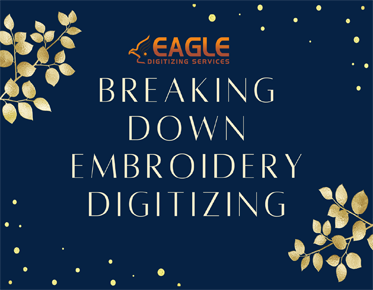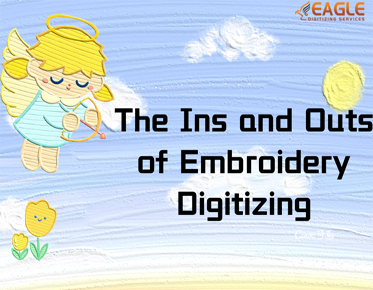Breaking Down Embroidery Digitizing: How Hard Can It Be?
Embroidery digitizing is the meticulous process of transforming artwork or designs into digital files that can be interpreted and executed by embroidery machines. It acts as the vital link between the creative vision of a designer and the tangible, embroidered reality. This process holds immense importance in the world of embroidery, as the quality of digitizing directly impacts the final outcome of the embroidered product.
Understanding
Embroidery Digitizing Software
Embroidery digitizing software as the digital canvas for embroiderers, providing a comprehensive toolkit to translate intricate designs into machine-readable formats. These software packages are specifically tailored to the unique requirements of embroidery digitization, offering a range of features and functionalities to streamline the process.
In essence, these software programs act as virtual design studios, empowering users to manipulate elements such as stitch types, densities, and colors with precision and ease. Some of the common features found in embroidery digitizing software include stitch editing tools, automatic digitizing functions, and support for various file formats.
Among the popular options in the market are industry-leading software like Wilcom EmbroideryStudio, Pulse Embroidery Software, and Hatch Embroidery, each offering its own set of capabilities and customization options tailored to the needs of both novice and experienced digitizers.
The
Digitizing Process
Embarking on the journey of embroidery digitizing involves a systematic approach, beginning with the preparation of the design and culminating in the testing and fine-tuning of the digitized file. The process typically unfolds in several distinct stages:
Preparing the Design: This
initial phase entails selecting or creating the artwork to be digitized.
Factors such as design complexity, size, and intended use must be considered at
this stage to ensure a smooth digitizing process.
Setting up the Digitizing Software: Once the design is finalized, it is imported into the digitizing software,
where it undergoes further refinement. This may involve resizing, cropping, or
adjusting the design to fit the desired embroidery area.
Digitizing the Design: With the
design loaded into the software, the digitizing process begins in earnest. This
involves assigning stitch types, defining stitch directions, and specifying
other parameters to accurately replicate the original artwork in embroidery
form.
Testing and Adjusting the Digitized Design: Once the digitizing is complete, the resulting embroidery file is tested on a sample piece of fabric to assess its quality and appearance. Any necessary adjustments or fine-tuning are made at this stage to ensure optimal results.
Key
Concepts in Embroidery Digitizing
Embroidery digitizing encompasses a range of technical concepts and principles that are essential for achieving high-quality results:
Stitch Types and Their Uses:
Different types of stitches, such as satin stitches, fill stitches, and running
stitches, serve distinct purposes in embroidery digitizing, from outlining to
filling large areas.
Density and Stitch Length: The
density of stitches and their lengths play a crucial role in determining the
overall appearance and durability of the embroidered design.
Underlay Stitches: Underlay
stitches are foundational stitches that provide stability and support to the
top layers of stitches, ensuring smooth and even embroidery results.
Pull Compensation: Pull compensation is a technique used to counteract the natural stretching or distortion of fabric during the embroidery process, helping to maintain the integrity of the design.
Challenges
in Digitizing
While embroidery digitizing offers endless creative possibilities, it also presents its fair share of challenges:
Complex Designs: Intricate or
highly detailed designs can pose challenges in terms of digitizing accuracy and
stitch placement, requiring careful planning and execution.
Fabric Type and Texture:
Different types of fabric, such as stretchy knits or textured materials, may require
special considerations and adjustments to achieve optimal embroidery results.
Thread and Needle Selection: The
choice of thread and needles can significantly impact the final appearance and
durability of the embroidered design, necessitating careful selection and
testing.
Color Matching: Achieving accurate color representation in embroidery digitizing can be challenging, particularly when working with a wide range of thread colors and shades.
Tips for
Successful Digitizing
Mastering the art of embroidery digitizing requires practice, patience, and a willingness to learn. Here are some tips to help you along the way:
Start with Simple Designs: Begin
by digitizing simpler designs to familiarize yourself with the software and
basic techniques before tackling more complex projects.
Understand Your Software: Take
the time to explore and understand the features and functionalities of your
chosen digitizing software to maximize its potential.
Pay Attention to Detail: Precision
is key in embroidery digitizing, so pay close attention to details such as
stitch placement, density, and color accuracy.
Practice and Experimentation: Don't be afraid to experiment and try new techniques. The more you practice, the more confident and skilled you'll become in embroidery digitizing.
Outsourcing
vs. In-House Digitizing
When it comes to embroidery digitizing, businesses have the option to outsource digitizing services or handle it in-house. Each approach has its own set of advantages:
Advantages of Outsourcing: Outsourcing
embroidery digitizing to professional digitizing services offers several
advantages, including access to expertise, cost-effectiveness, and time
savings. By entrusting digitizing to experts, businesses can focus on their
core operations while still enjoying high-quality results.
Advantages of In-House Digitizing: On the other hand, in-house digitizing provides businesses with greater control and flexibility over the digitizing process. By investing in digitizing software and training, businesses can digitize designs in-house, tailoring them to their specific needs and preferences.
Cost
Considerations
Budgeting for embroidery digitizing expenses involves accounting for various factors, including:
Software Costs: The initial
investment in digitizing software can vary depending on the features and
capabilities required.
Labor: Whether outsourcing or
handling digitizing in-house, labor costs should be factored into the overall
budget.
Equipment Maintenance: Regular maintenance and upgrades for embroidery machines and digitizing software should be included in long-term budget planning.
Future
Trends in Embroidery Digitizing
As technology continues to evolve, we can expect to see several trends shaping the future of embroidery digitizing:
Advancements in Digitizing Technology: Continued advancements in digitizing software and hardware are likely
to improve efficiency, accuracy, and customization options.
Integration with Other Design Processes: Embroidery digitizing may increasingly be integrated with other design
processes, such as graphic design and 3D modeling, to create innovative and
dynamic embroidery designs.
Customization and Personalization Trends: The demand for customized and personalized products is on the rise, driving the need for more flexible and adaptable digitizing solutions.
Conclusion
Embroidery digitizing is both an art and a science, requiring a blend of creativity, technical expertise, and attention to detail. By understanding the key concepts, mastering the tools and techniques, and embracing the challenges and opportunities it presents, anyone can embark on a journey of discovery and creativity in the world of embroidery digitization. So, let your imagination soar, and watch as your digital designs come to life stitch by stitch.
And if you're looking for an easy and
affordable way to digitize your designs, consider Eagle Digitizing. With our
unparalleled expertise and unwavering commitment to quality, we transform your
vision into reality with precision and perfection.



